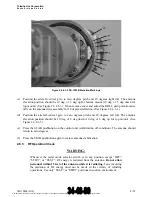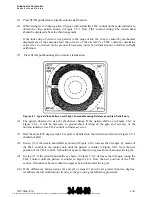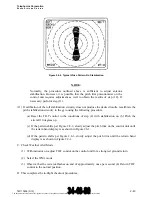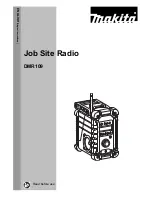
Telephonics Corporation
R
A D A R
S
Y S T E M S
D
I V I S I O N
2-28
TM113806 (3/10)
2.5
INSTALLATION OF EQUIPMENT
2.5.1
DA-1503B Antenna Drive Unit and AA-1504A Antenna Array
2.5.1.1 Assembly of Antenna Array and Antenna Drive Unit
(a) Remove the V-band coupling assembly (see Figure 2.4.1-1) from the antenna drive assembly.
Remove the metal cap covering the waveguide port.
(b) Butt the antenna array against the antenna drive assembly making certain that the array engages the
guide pins located on the drive assembly. Secure the array/drive assembly together by reinstalling
the V-band coupling assembly.
(c) Torque the two cap screws on the V-band coupling assembly 22 to 24 inch-pounds.
2.5.1.2 Installation of Antenna Assembly
The radar antenna is designed for mounting at the bottom or top of the aircraft. The normal mounting
configuration is on the bottom of the aircraft and the unit’s boresight sensor has been factory aligned
for bottom mounting. If the antenna drive is top-mounted, the unit is wired to rotate in the opposite
direction and the boresight sensor must be re-aligned. Refer to the DA-1503B Maintenance Manual
(TM109202) for boresight sensor re-alignment procedure.
The antenna drive should be enclosed by a radome fabricated to the operating frequency of the radar
system. The total space required for the antenna assembly can be determined from the dimensional
information on the outline drawings for the antenna drive unit and antenna array.
The antenna base hole pattern allows for orientation of the antenna with reference to the azimuth axis.
Machined surfaces on the antenna base are provided to align the antenna in the pitch, yaw, and roll
axes within 0.25 degree (See Figure 2.4.1-1). Alignment of the mounting pads can be checked by using
an accurate spirit level prior to the actual mounting of the antenna. Antenna alignment can be checked
in service by means of the electrical tests outlined in Paragraph 2.6 (Post-Installation Check).
2.5.1.2.1
Shock Mounting and Ventilation
Shock mounting is not required. The antenna is designed to operate in an un-pressurized section of the
aircraft and ventilation is not important.
2.5.1.2.2 Pressurization
The antenna is designed to operate within ambient air pressures ranging from sea level (and below) to
an altitude of 35,000 feet (DA-1503B), without pressurization. The antenna is installed in a section of
the aircraft that is not normally pressurized. Thus, if the R-T unit is installed in a pressurized cabin
section, the electrical and RF transmission lines feeding the antenna must be brought into the antenna
location area through the use of an airtight seal at the bulkhead feed through. A pressure window
should also be placed in the installation waveguide.
The document reference is online, please check the correspondence between the online documentation and the printed version.
















































